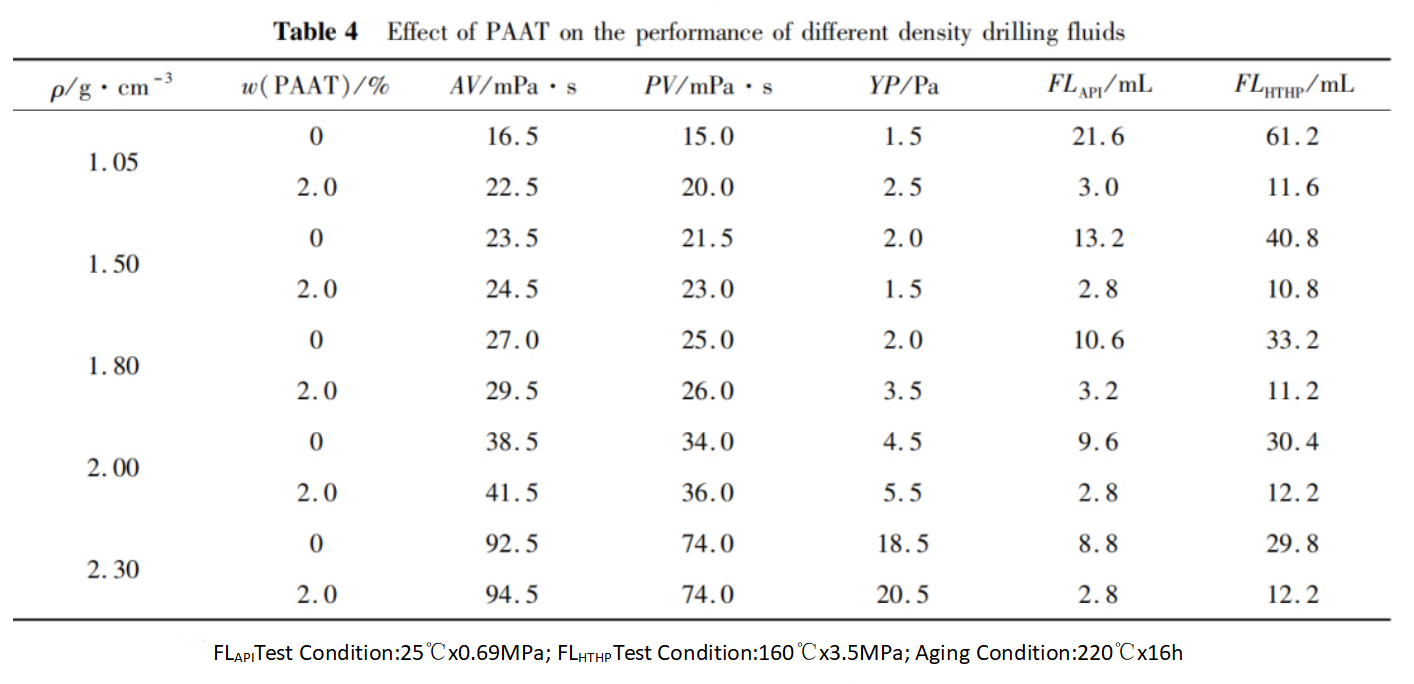Synthesis and Performance of Microcrosslinked Polymer Fluid Loss Additives(Part 2)
2.3 Performance of PAAT in Drilling Fluid Systems
(1). The Effect of PAAT on the Performance of Freshwater Based Slurry
Table 2 shows the effects of different dosages of PAAT on the rheological properties and filtration performance of freshwater based slurries.
From Table 2, it can be seen that as the amount of PAAT increases, the viscosity of the fresh water slurry before and after aging increases, while the dynamic shear force slightly increases. But the filtration loss significantly decreases with the increase of PAAT dosage. After adding 1.5% PAAT, the API filtration loss of the base slurry before and after aging was 3.8 and 6.4 mL, respectively. The high-temperature and high-pressure filtration loss after aging at 220℃ for 16 hours was only 19.8 mL, indicating that PAAT has the ability to regulate rheology and reduce filtration loss. This is because the cross-linking points in the molecular structure of PAAT can greatly limit the free movement of molecular segments, and together with the rigid sulfonic acid side groups, enhance the mechanical and chemical stability of the segments, which is beneficial for the polymer to maintain its high polymer properties and adjust the rheological properties of the slurry,and PAAT can adsorb on the surface of clay particles through the amide and sulfonic acid groups on its side chains, playing a protective role, increasing the viscosity of the filtrate liquid phase, improving the compactness of the filter cake, and ultimately reducing filtration loss.

(2) . The Effect of PAAT on the Performance of Compound Brine Based Slurry
Table 3 shows the effects of different dosages of PAAT on the rheological properties and filtration performance of compound brine based slurries.
From Table 3, it can be seen that with the increase of PAAT dosage, the viscosity of the composite saline based slurry before and after aging also increases, and the dynamic shear force slightly increases, and the filtration loss significantly decreases with the increase of PAAT dosage. After adding 2.0% PAAT, the API filtration loss of the base slurry before and after aging was 5.8 and 9.8mL, respectively. The high-temperature and high-pressure filtration loss after aging at 220℃ for 16 hours was only 23.6mL.
The results indicate that PAAT still has strong molecular structural stability when subjected to high temperature and high concentration of mineral ions simultaneously. It not only maintains the characteristics of polymers, but also the synergistic effect between polymer molecules and clay particles is not easily disrupted. Therefore, adding PAAT can help maintain a certain viscosity and good rheological properties of the composite saline based slurry, while improving the quality of filter cakes and achieving the goal of reducing filtration loss.

(3).The Effect of PAAT on the Performance of Drilling Fluids with Different Densities
Table 4 shows the performance of different density drilling fluid systems with 2.0% PAAT after aging.
From Table 4, it can be seen that the rheological properties of the drilling fluid system after the addition of PAAT have little change compared to before the addition, while its API and high-temperature high-pressure filtration rates have significantly decreased, with API filtration rates below 4.0mL and HTHP filtration rates below 13.0mL. So the high temperature resistant and water loss reducing agent PAAT has good adaptability to drilling fluid systems with different densities.

3.Conclusion
Preparation of tetraenol crosslinking agent monomer EAAD using aziridine, 3-chloropropene, and ethylenediamine as raw materials;Then, using EAAD, acrylamide, 2-acrylamido-2-methylpropanesulfonic acid as raw materials, a water soluble micro crosslinked copolymer fluid loss additive PAAT was synthesized through aqueous solution free radical copolymerization reaction.
PAAT can withstand high temperatures of 220 ℃ and maintain the filtration rate and rheological properties of drilling fluid under high temperature and high salinity conditions. The API filtration rate is less than 4.0mL, and the high-temperature and high-pressure filtration rate is less than 13.0mL.
Our company, DICO Energy Co., Ltd, has developed and produced a series of fluid loss agent products, and the list of these products is as follows. About the specific information of each product, you can search it on our official website www.dicoenergy.com. Welcome to inquire and purchase!

